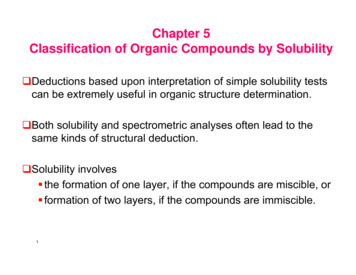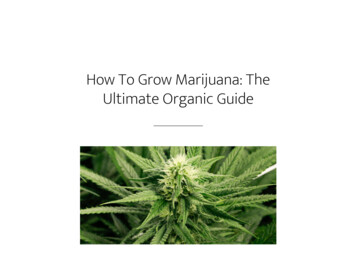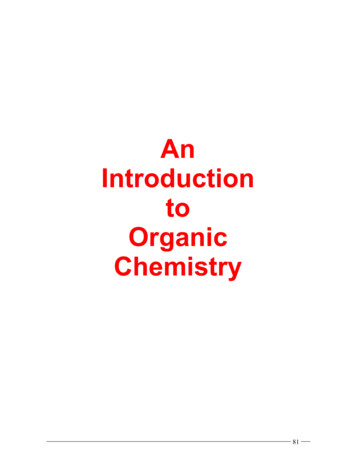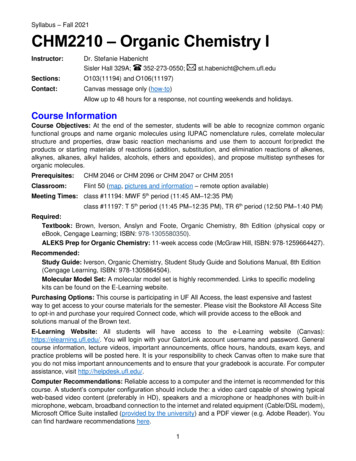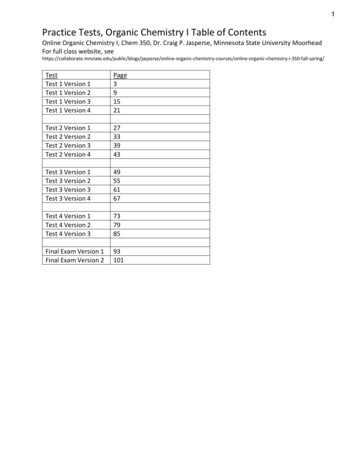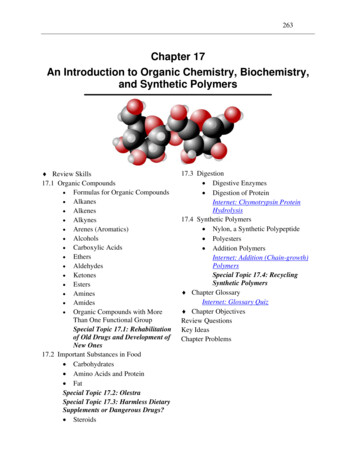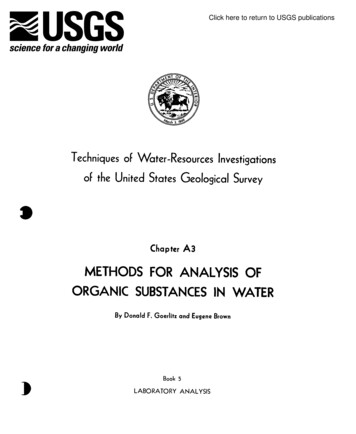
Transcription
Click here to return to USGS publicationsTechniques of Water-ResourcesInvestigationsof the United States GeologicalSurveyChapter A3METHODS FOR ANALYSIS OFORGANIC SUBSTANCESIN WATERBy DonaldF. Goerlitzand Eugene BrownBook 5LABORATORYANALYSIS
DEPARTMENTWILLIAMOF THE INTERIORP. CLARK, SecretaryU.S. GEOLOGICALSURVEYDallas L. Peck, DirectorFirst printing 1972Second printing 1972Third printing 1984UNITEDSTATESGOVERNMENTPRINTINGOFFICE, WASHINGTON: 1984For sale by the Distribution Branch, U.S. Geological Survey604 South Pickett Street, Alexandria, VA 22304c
PREFACEThe series of manuals on techniques describes procedures for planning andexecuting specialized work in water-resources investigations. The material isgrouped under major subject headings called books and further subdivided intosections and chapters. The unit of publication, the chapter, is limited to anarrow field of subject matter. This format permits flexibility in revision andpublication as the need arises. Section A of Book 5 presents techniques usedin water analysis.Provisional drafts of chapters are distributed to field offices of the U.S.Geological Survey for their use. These drafts are subject to revision because ofexperience in use or because of advancement in knowledge, techniques, orequipment. After the technique described in a chapter is sufficiently developed,the chapter is published and is for sale by the U.S. Geological Survey, 604South Pickett Street, Alexandria, VA 22304.III
CONTENTSPagePreface---- - - -.------.-----------.-----.Abstract - - - . - . . Introduction -. - - . - . - - -Part&Sampling--- . - -Sample preservat,ion. - . .References- - - - . . . . . . . .Part II, Analysis of samples- .Carbon, all forms . . -References. - - . - . .Chlorophyk .Extractive spectrophotometric methodReferences - . .Color - - - . . - -. - Comparison method-References -- . -Extractable organic matter- .Oilsandwaxes - - . References- - . - - -. -Methylene blue active substances - -Synthetic anionic detergents-References- -.- --- --. .- Nitrogen, ammonia. - -Distillation method .References -Nitrogen, nitrate- - - - . .Brucine method- ---- -- .-- - -Reduction method . - - .III112344466688899911111113131315151517PagePart II, Analysis of samples-ContinuedNitrogen, nitrate-ContinuedReferences- . . . .Nitrogen, nitrite . . . . .Diazotixation method- . . - -References-. . . . - .Nitrogen, organic - -Kjeldahl method- .Reference- - -Oxygen demand, chemical (COD)- -Dichromate oxidation method . - .References - .Phenolic material . - -References.- . . . .Pesticides-gas chromatographic analysis-References- - . .Insecticides in water--Gas chromatographic method- .References . . -Chlorinated hydrocarbon insecticides in suspended sediment and bottom material .Gas chromatographic method-Chlorinated phenoxy acid herbicides in waterGas chromatographic method-Reference- .Chlorinated phenoxy acid herbicides in sediment (tentative)- - -Gas chromatographic method-.TABLESPageRetention values for chlorinated hydrocarbon insecticides2. Retention values for phosphorothioate insecticides3. Retention values for methyl esters of chlorinated phenoxy acid herbicides- .4. Insecticides in water: recovery of compounds added to surface-water 3233333535393939
METHODS FOR ANALYSIS OF ORGANICBy DonaldF. GoerlitzThis manual contains methods used by the U.S. Geological Survey for the determinationof organic substancesin water. Procedures are included for the following categories of organic substances: Organic carbon, chlorophylls,color, detergents, nit,rogen, oils and waxes, oxygen demand(chemical), phenolic materials, herbicides, and insecticides. Procedures are also given for the determinationofchlorinated hydrocarbon insecticides, as well as chlorinatedphenoxy acid herbicides, in sediment and bottom materials.IntroductionThe yellow or brown color commonly associatedwith natural water is often the result of the decomposition of naturally occurring organic matter.The most abundant sources of this material include decaying vegetation, algae, and microscopicorganisms. These substances are produced mostlyon land and during runoff are flushed into thewater, where complex biological processes continue. The role of natural organic substances inwater processes is not very well understood.These compounds are known to aid in transporting and solubilizing many trace elements and areimportant in weathering. Further, natural organic substances interact with both organic andinorganic pollutants.In addition to organic matter from naturalsources, increasing amounts are entering wateras a direct and (or) indirect result of man’sactivities. Leading sources of this material areindustrial and domestic waste, agriculture, urbanrunoff, mining, and watercraft. Foaming detergents have been observed in water supplies. Fishkills have been caused by toxic chemicals andhave been linked to nutrient-inducedalgaeblooms, which deplete the dissolved oxygen.SUBSTANCES IN WATERand EugeneBrownBecause of the myriad of sources from bothpollution and natural processes, organic matteris present in almost all surface and ground watersand directly influences the water quality.In reviewing water-qualityreports, one mayobserve that although color, oxygen consumed(chemical oxygen demand), and other criteria forthe analysis of organic substances are describedin the introductory remarks, seldom are such dataincluded in the tables of the report. These dataare noticeably absent from past reports becausesuch crude measurements did not appear to serveany meaningful purpose in explaining most waterprocesses. The value of even the most primitivemeasurements of organic substances in water isapparent, considering the general awareness ofman’s effect on the environment and the implementation of programs to stem the tide of waterpollution, lake eutrophication, and similar problems.The purpose of this manual is to provide directions for collection and analysis of water samplescontaining organic substances as required by theGeological Survey in making water-qualityinvestigations. This manual is an updating andcornpositing of the organic analytical methodscontained in Geological Survey Water-SupplyPaper 1454, “Methods for Collection and Analysisof Water Samples” (Rainwater and Thatcher,1960). The intense activity in the field of organicanalysis is providing new and improved methods,and as appropriate methods become availablethey will be added to this manual. All methods aswritten may be subjected to revision from timeto time. Methods labeled as tentative are assumed to be adequate but need further testingbefore final acceptance.
2TECHNIQUESOF WATER-RESOURCESINVESTIGATIONSPart I. SamplingRefer to Part I, Chapter Al of Book 5, forinformationon site selection, frequency, fieldsafety, and first aid. Before a proper samplingprogram can be initiated, the nature of theorganic compounds sought must be considered.As a general rule, organic compounds having lessthan six carbon atoms are water soluble, whereascompounds with more than six carbons are not.This generalization must be applied with care,however, because the presence of hydroxyl orother polar sites on a molecule increases itssolubility. Even very soluble compounds, however, may prefer to reside on organic-layeredsediment. Further, some insoluble compoundsmay be suspended on the water surface. In summary, organic matter in a body of water may bedistributed on the surface, in suspension, adsorbed on suspended sediment, in bed materials,and (or) in solution.Because of this wide and generally unpredictable distributionof organic material in abody of water, the collection of a truly representative sample requires a great deal of careand often requires the use of specialized samplingequipment.In most instances, samples fororganic analysis are best collected with the sameequipment and technique used for the collectionof samples for suspended-sedimentmeasurements. The technique and equipment used insuch measurements have been extensively studied, and they are discussed at length in one of aseries of reports by the Inter-Agency Committeeon Water Resources (1963) and, more recently,in a report by Guy and Norman (1970). Whenmore elaborate equipment is not available, asimple weighted bottle may often be used forsampling wells, lakes, and slow-moving streamswith little suspended sediment. Other availablesamplers have rubber gaskets and valving arrangements that may either contaminate thesample or remove organics from the water byadsorption. Such devices as the DH-48, D-49,or the P-46 samplers, which are specially designed to collect suspended-sedimentsamplesfrom fast-movingstreams at water velocity,must be modified for organic sample collection.Most importantly, all the neoprene gaskets mustbe replaced by inert plastic material, such asteflon, and oil must be eliminated from valves.Organic substances on the water surface orincorporated in the bed material present verydifficult sampling problems. Surface films mayappear chronically or intermittentlyand mostoften come from accidental spills or seepage.Samples taken from the surface of a body ofwater, especially moving water, are aImost impossible to evaluate. Quite often the samplesmust be related to the total volume of water,surface area, film area, and film thickness. Atpresent, no universally acceptable surface samplers are available, and investigators are requiredto fabricate their own. Floating hoops or rectangles covered with clean metal foil whichdelineate an area and allow skimming a surfacesample from calm water have been used withlimited success. Other methods for collectingfilms and slicks from surface waters, such as“dustpan skimmers,” absorbent cloths, and floormops, have been used, but none have beensatisfactory for general application. The methodmost often used for describing a problem areawhen surface films are involved is identificationof the material, locating the source, and thenestimating the amount entering the water.A rational approach to site selection forsampling stream bottoms is also difficult. Fortunately, bed-materialsamplers are available.Ideally, bottom material, including that which ismoving by saltation, rolling, or otherwise driftingalong the streambed, should be included. It isalso desirable to collect the water from the 3 or4 inches of flow immediately above the streambottom. This is commonly called the “unsampledzone,” because it is not sampled by suspendedsediment samplers or most other water-samplingdevices because of mechanical limitations.Bed-material and suspended-sediment samplersmay be obtained through the Federal InterAgency Project, U.S. Army Engineer District,St. Paul, Minn. One of these is the piston-typebed-material hand sampler BMH-53 for shallowwater, and the other is the BM-54 or BM-60bed-material sampler for deeper water. Both ofthese are constructed to prevent sample washoutwhen raised to the surface. Bed-material samplersto sample at the interface are now under development and should be available soon.Most investigations are not concerned withsurface or bottom material. but rather with thatwithin the body of the water. Most of samples arela
ANALYSISBOF ORGANICcollected from just beneath the surface of thestream to as near the bottom as the samplingapparatus will allow. Accurate samples are takeneither by depth integration or at a number ofpoints in a transverse cross section. For smallstreams, a depth-integratedsample or a pointsample taken at a single transverse positionlocated at the centroid of flow is usually adequate.Larger streams require selrction of several verticals at centroids of equal flow after careful andoften extensive measurement. Depth-integratedsamples may also be taken by the ETR (equaltransit rate) method, at equally spaced pointsacross the stream cross section. In collectingthese samples, the sampler is lowered and raisedat each sampling point in the same length of time(Guy and Norman, 1970). Lakes are sampled onthree-dimensional grids consistent with the shapeand depth of the water body. Wells may bcsampled from the pump, provided the oils fromthe mechanism do not contaminate the sample,otherwise a bottle sampler should be used.Cornpositing samples in the field is not recommended. Individualsamples for cornpositingshould be taken to the laboratory, where carefulcontrol can be maintained. Organic sedimentsand soils tend to cling to sample containers, andspecial precaution must bc taken to avoid improper handling.Glass bott,les are the most acceptable containers for collecting, transporting, and storingsamples for organic analysis. Glass appears to beinert relative to organic materials and can withstand a rigorous cleaning procedure. Becauseorganic materials are so plentiful in the environment, it is extremely diflicult to collect samplesfree from extraneous contamination.Apparntusfor sampling or processing samples must bescrupulously clean. Sample bot.tles, espccislly,must bc free of contaminating materials, Bostonround glass bottles of I-liter capacity withsloping shoulders and narrow mouths arc satisfactory for most applications. The closure shouldbe metal, preferably inert, and lined with teflon.This plastic is the only organic material thatshould bc allowed t,o contact the sample.All sample bottles, whether new or used, mustbe cleaned before collecting organic samples, andthe following procedure is recommended : Afterwashing in hot detergent solution and rinsing inwarm t,apwater, the bottles are rinsed in diluteSUBSTANCES3IN WATERhydrochloric acid. Following a rinse in distilledwater, the glass containers are put into an ovenand heated at 300 C (Celsius) overnight. Thetcflon cap liners and the metal closures arewashed in detergent. After rinsing with distilledwater, the caps are set aside to air-dry. The linersarc rinsed in dilute hydrochloric acid and thensoaked in redistilled acetone for several hoursand heated at 200 C overnight. When the heattreatments are completed, the bottles are removedfrom the oven and capped with the closure andteflon liner. The clean bottles are usually storedor shipped in a “duo-pnk”container-aformfitting expanded polystyrene case in a corrugntcdcardboard carton.In actuality,the analysis begins with thecollection of the sample. The sample mustrepresent the body of w&r from which it wascollected at the time it was taken. The importanceof the sample to the final result cannot be overemphasized. If possible, an analyst or a persondirectly concerned with the particular studyshould collect the samples. Inexperienced pcrsonncl should never be allowed to collect samplesunless they arc very closely supervised. If possible, the principal investigatorshould givepersonal instruction on ssmple collection. In allinstances, detailed printed instructionsshouldaccompany each set of sample bottles. The samplc containers should always be sent from the laboratory dire&y to the person taking the samplesjust before sampling. Extra or spare samplebottles should be actively inventoried and remainunder the control of the laboratory.SamplepreservationMost water samples for organic analysis mustbe protected from degradation. Provisions forrefrigerating or otherwise preserving the sampleshould be available. Icing is the most acceptable method of preserving a sample, but itis not always possible. Timing of collectionshould bc arranged so that the sample can reachthe laboratory in a minimum of time. There is nosingle preservat,ive that may be added to asample for all forms of organic analysis, but eachsample must be treated according to the analyticalprocedure to be performed. For the determinations in this manual, the following general methods
4TECHNIQUESof sample preservationOF WATER-RESOURCESshould be used:Oxygen demand, chemical: Add concentratedH2S04 (sp gr 1.84) at a rate of 2 milliliters (ml)per liter of sample.Carbon, inorganic: Refrigerate at 4 C.Carbon, orgwr2ic: Add concentrated HZ04 at arate of 2 ml per liter of sample and refrigerateat 4 C.ChZoroph.ylls: Refrigerate at 4 C.Color: Refrigerate at 4 C.Oils and loaxes: Add concentrated H,SO, untilthe pH of the sample is below 3.0. Generally, 5ml per liter will be sufficient.Surfactants: Refrigerate at 4 C.Nitroyen: Add 40 milligrams (mg) of HgCLper liter of sample and refrigerate at 4’C.Phenolic material: Acidify sample to pH 4.0with HIPOJ, add 1.0 gram (g) CuSOI-5Hz0 perliter of sample, and refrigerate at 4 C.Herbicides: Acidify with concentrated H,SO,at a rate of 2 ml per liter of sample and refrigerateat 4’C.Insecticides: None requiredfor chlorinatedcompounds.ReferencesGuy, H. P., and Norman, V. W., 1970, Field methods forthe measurementof fluvial sediments: U.S. Geol.Survey Techniques Water-ResourcesInv., book 3,chap. C2, 59 p.Rainwater,F. H., and Thatcher,L. L., 1960, Methodsof collection and analysis of wat.er samples: U.S. Geol.Survey Water-SupplyPaper 1454, 301 p.[U.S.] Inter-AgencyCommittee on Water Resources, 1963,A study of methods used in measurement and analysisof sediment loads in streams, in Determinationoffluvial sediment discharge: Washington,U.S. Govt.Printing Office, Rept. 14, 151 p.Part II. AnalysisCarbon,of samplesall formsThe procedure given affords an accurate determinationof carbon in water in solution aswell as in suspended matter. Both organic andinorganic carbon can be selectively measured.The organic carbon determination gives a muchtruer measure of the organic matter present inaqueous solution and (or) suspension than doesINVESTIGATIONSthe chemical oxygen demand determination. Thistechnique is not hampered by the presence ofreducing substances or affected by the type oforganic material being oxidized. It cannot, however, be used to replace t.he biological oxygendemand determination.1. Summary of methodUsing a microsyringe, a fraction of a milliliterof sample is injected into a combustion tubeunder a sweep of oxygen gas. All the carbon inthe sample is converted to carbon dioxide andmeasured by use of a nondispersive infraredanalyzer (Van Hall and others, 1963).2. ApplicationWater containing carbon from about 1.0 mg/l(milligramper liter) to 1,000 mg/l may beanalyzed directly. For a more sensitive procedure,the analyst is referred to the work of Menzel andVaccaro (1964). Higher carbon concentrationsmustbe diluted.Water containingorganicparticulatematter may be analyzed directlyprovided the largest. particle diameter is 6-i thesyringe needle diameter. Otherwise, the particlesmust be reduced in size by homogenizing orblending, and the resulting suspension must befairlyuniformand stable.Depending on the sample treatment,should be reported as follows:results2.1 Total carbon: Sample analyzed withoutfiltration or acidification.2.2 Total organic carbon: Sample analyzedwithout filtration, but acidified and purged withinert gas to remove inorganic carbon.2.3 Dissolved carbon: Sample analyzed afterfiltration, but without acidification.2.4 Dissolved organic carbon: Sample analyzed after filtration and acidification and purgingto removeinorganiccarbon.In addition to these reporting forms, concentrationsof inorganic carbon (dissolved andsuspended) and suspended carbon (organic andinorganic) may be computed by differences fromthe above measurements.3. InterferencesStrongly acidic solutions and some brinesinterferewith this technique by producinginfrared-absorbingfogs. Very volatile carbon0
a-ANALYSISOF ORGANICcompounds m:Ly Ix lost during c:u on:ltc climimbtion. Tnjcctions in cscess of 0.08 ml rrsult inincomplctc coniI)ust.ion owing t,o thr Lrgc volumeincrr:lsr :issoci:itrtl with thr w:itrr v:qx riz;btion.4. Apparatus4.1 C’admaccou s arral!ytw, I%xkm:m hIodr111.5-A, ;\lodrl 915, or rqlCvnlrnt .4.2 :Ili li(er s!/r.i c/ , lOO- 1 (microliter)c:lp:bcity with I:qq orcncrtllc.4.3 :llicr n l/ralio ral)pnrallLs: ITsc only silvermct,:il fiIt.crs h:hving 0.45 pm (micrometer) m:lsimu111porr size, obt.:linnI)lc from Scl: s Flot,ronics.Filters should IW hc:ltcd :It 300 C’ overnight torcmovc 0rg:mic ni:lt.tcr.5. ReagentsAll rrngrnts must br chrckrd for org:mic contimCn:ltion.5.1 C’arbf))tate-bica,bo,,alc st:md:vd solut,ion,1.00 ml 1.00 mg c:irIBon: Dissolvr 3.500 gsodium IGxrhon:btr nnd 4.418 g sodium CAThon:ltr, both dried :it, 105T for 1 hr (hour), inc:u on-fror distillrtl w:itrr :mtl tlilutr to 1,000 ml.5.2 H ytlrwltlor ic acid, concrntr:lt,ctI (sp gr1.19).5.3 .V lrqa0 gas, frrc of c:irhon clioxidc :mtlorgmic impurities.5.4 Os!/ /r t/gas, frcr of c:u on tlioxidr :mtlorg:mic impriritirs.5.5 l’olassiunrk (l,oqerf ptrlhalale st:bnd:udsolution, 1.00 ml 1.00 mg cxhon:Dissolvr2.128 g pot: ssium hydrogen pht,h:d; tr, primqst:tntl:brtl gr:&, which h:ts brrn drircl :It 105 C’for 1 hr, in cxhon-frrc distillrd w:ltcxr :mtl dilut,rto 1,000 ml.6. Procedure36.A It struwc t sfat/rla rtizatio,t6.A.l Si,r &cha,tUeza/tal!/zets, Beckm:mMotlcl 115-A, or rquivnlcnt.6.A.J.l Prrp:irc:I srrirs of st:lnd:brtlscont,:kining 5, 10, 20, 40, 60, :mtl 80 mg/l ofc:u on by dilution of thr pot:esium hydrogrnphth:Wa st:mtl:ud stock solution.6.A.1.2 Succrssivrly introduce 20- 1 s:Lmplcs of the 20-mg/l st:tnd: rtl into the c:irbonncrous nn: -zer until t.he rcsnonsc is rrtxoduciblc.Allow t.1 ; recorder to return t,o t,hc origin,zlSURSTANCESIN WATER.;Ixlsrlinr bat,wrrn injections. Run duplicntr dctrrmimltions, :it, the Ie:Ist,, for ench st:mdnrd nndplot, thr milligr:lms prr liter rif c:u on versus pcnkbright. mr:lsurcxcl from Ix srlinc on the rrcordrr.6.A.2 Dual-cha /wl a,lalyter, l3rckm:m Model915, or tquiv:blcnt .6.A.2.1 Prrp:lrc :I st.:mtl:vd curve for t,hrorgnnic carbon ch:mnrl of thr :mnlyzrr ns in step6.A.l :Lbovr.6.A.2.2 Prcpnrc :I st:md:ird curvr for theinorg:mic chnnnrl of the :m: yzrr, using the s:n-nctrchniqur, by injrct,ion of st:mtl,zrds prcpnrrd bydilution of the c:lrbon:lt,c-I,ic:lrbon:Lt,r stock stnnd3rd.6.13 A nabysis of samples6.1S.l Sim-Je-chan el analyzer6.B.l.l Drprnding on how the results tlrcto Ix reported, the snmple may be fi1tcrc.d and(or) ncidificd. If the s:lmplc is to Ix filteredt,hrough thr met:kl mcmbranc filtrr, the filtrntionmust hc done hcforc :bcidificntion. Only enoughfilt,rntr for the dctrrminxtionnerd bc collcctcd.6.B.1.2 Adjust1 the pH of thr s:mplc to 2or 1)&w, using concrnt,r: t,cd hydrochloric acid,:tntl slowly Imhblr nitrogen g: s through thr solution for 3-5 min (minutes) to purge carboncliosidr.6.B.1.3 Mix the s:unplc wrll. Inject 20-80 1 of the s:unplr int,o the combustion tubr, usingthe s:imr t,rchniqur :LSfor tho stnnd: rds. ltrcordthr pc:lk hc ightn from :tt Ic:lst two drtcrmimrtionsfor exh s:unplc.6.R.1.4 Prep:ux! :I hlnnk from c:vbon-frer(list illcd w:lt,rr nnd nll t,hr rrngrnts nsed, nnd;tn:blyzr thr Wink :LS the s:rmplc. If morr t.hnn1 percent, of s:Llts is present in the snmplr, thehlnnk should hc prcp:lrcd simil:trly.6.13.2 Ikd-chat/?/e1alralyzer6.13.2.1 Drprnding on whothrr results nredrsirrtl for tot,:&1or dissolved cnrbon, the samplemng Ix injected untrcntrd, or filtered throughthr 0.45-pm silver filter, hut trot ncidificd.6.n.2.2 M:lko duplicntc 20- 1 inj&ionsofr:lch s:lmplr into c:lch chxnnel of the :hnnlyzcr,using thr snme technique :ts in the prrparntion ofthr st:tndnrd curves.7. Calculations7.A Siq e-chartlIeanalpel7.A.l Concrntmtionsof carbon,grnms per liter, :trc ol)t:Gncd tlirectlyin millifrom np-
TECHNIQUES6OF WATER-RESOURCESpropriate standard curves, depending on thesample treatment used.7.B Dual-channel analyzer7.B.l Concentrations of inorganic and inorganic-plus-organiccarbon, in milligrams perliter, in each sample are obtained from theappropriate standard curves.7.B.2 By difference, compute the concentrat,ion of organic carbon, in milligrams per liter.When this difference is small and the determinedvalues are large, results should be verified. Thismay be done by injecting an acidified, nitrogenpurged sample into the high-temperature furnaceto obtain a direct measure of organic carbon.Extractive1. SummaryReportCarbon concentrations are reported as follows:Less than 10 mg/l, one significant figure; 10mg/l and above, two significant figures.9.spectrophotometricmethodof methodIndividual chlorophylls are determined simultaneously withoutelaborate separation. Thesample is filtered, and the cells retained on thefilter are mechanically disrupted to facilitateextraction of pigments into a solvent composed of90 percent acetone and 10 percent water (volumeper volume). The concentrations of chlorophyllsare calculated from measurements of absorbanceof the extract at 4 wavelengths, corrected for thego-percent acetone blank.2.8.INVESTIGATIONSApplicationThe method is suitable for all natural waters.The volume of water filtered should contain lessthan 10 pg (micrograms) chlorophylla. (SWstep 6.1.)3. InterferencesPrecisionNo precision data are available, but resultsare believed reproducible within flmg/l atthe lOO-mg/l level.ReferencesBeckman Instruments,Inc., 1966, Laboratorycsrbonaceous analyzer: Beckman Instructions137879, Fullerton, Calif., 27 p.1968, Total organic carbon analyzer: Beckman Instructions 81706-B, Fullerton, Calif., 34 p.Menzel, D. W., and Vaccaro, R. F., 1964, The measurement of dissolved organic and particulatecarbon inseawater: Limnologyand Oceanography,v. 9, p.138-142.Van Hall, C. E., Safranko, John, and Stenger, V. A., 1963,Rapid combustion method for the determinationoforganicsubstancesin aqueous solutions:Anal.Chemistry, v. 35, p. 315-319.ChlorophyllsThe concentrationsof photosyntheticpigments in natural waters vary with time and withchanging aquatic conditions. Chlorophylla, b,and c concentrations are used to estimate thebiomass and the photosyntheticcapacity ofphytoplankton.Ratios between t,he differentforms of chlorophyll are thought to indicate thetaxonomic composition or the physiological stateof the algal community.Large amounts of inorganic sediment in thesample may clog the filter. Erroneously highvalues may result from the presence of fragmentsof tree leaves or other terrestrial plant material.The presence of phaeopigments, the decomposition products of chlorophyll, results in overestimates of chlorophylls (Yentsch, 1965, 1969;Lorenzen, 1965, 1967).4.Appomtus4.1 Filtratio,)equipment: Filter holder assembly, Millipore XX63 001 20, or equivalent,and a source of vacuum.4.2 Glasspestle-type tissue II omqfen Get*(grinder),15-ml capacity, Corning 7725, orequivalent. Motor drive with low-torque clutchto operate at about 500 rpm (revolutions perminute).4.3 nle&r.a,re jilter, Milliporc HAWP 047 00type, HA 0.45 pm mean pore size, white, plain,47-mm (millimeter) diameter, or equiv:tlcnt.4.4 Swing-out centrifuye, 4,000-5,000 .Saveguard centrifuge, Model CT-l 140, or cquivnlent.4.5 Spectropfrotometer (Beckman Model DU,or equivalent), with a bandwidth of 3 nm (nanometers) or less, allowing absorbance t,o bc readto fO.OO1 units. Use cells with a light-path of from
ANALYSISOF ORGANIC1 to 10 cm (centimeters). If only chlorophyll a isdetermined, instruments with interference filterswith not more than 5-10 nm (Beckman ModelR, or equivalent) half-bandwidth may be used.4.6 Vacuwn-pressurepu?llp,MilliporrXX60 000 00, or equivalent.5.Reagents5.1 Acetone solution : To 900 ml acetone, add100 ml distilled water.5.2 Maynesiwn carDonate, powdered.6.SUBSTANCESWATER7greater than 0.8.) If the 750-nm reading isgreater than O.O05/cm light-path,reduce theturbidity as mentioned in step 6.8.7.CalculationsSubtract the absorbance at 750 nm from theabsorbance at 663, 645, and 630 nm. Divide thedifference by the light-path of the cells, in centimeters. The concentrations of chlorophylls in theextract, as lg/ml (micrograms per milliliter), aregiven by the following equations:chlorophylla, in rg/ml 11.64c -2.16e36,5 0.10e 0chlorophyll b, in pg/ml -3.94c d-20.97ee46-3.66e630chlorophyll c, in pg/ml -5.53cw14.81ec,5 54.22e6,0Procedure6.1 Collect a sample of water which contains less than 10 g, and preferably about 1 pg,of chlorophyll a. A sample of 0.5-1.0 liter may beadequate for fresh or cstusrinc waters; 4-5 litersof ocean water may be required. Samples must berefrigerated at 4 C until t,ime of analysis.6.2 Cover the surface of a 0.45-pm membranefilter with finely powdered MgCQ, using about,10 mg/cm* of filt,er area (ahout 170 mg for the47-mm-diameter filter).6.3 Filter the sample at no more than twothirds atm (atmosphere).6.4 Fold the filter with the plankton on theinside and proceed immediately with the extmction and measurement steps. If the sample mustbe stored, dry the filter in a silica gel desiccatorin the dark at, 1 C or less. Dry ice is recommendedfor storing samples in the field.6.5 Place the filter in a glass homogenizer.Add 2 to 3 ml acetone solution. Grind 1 min(minute) at about 500 rpm.6.6 Transfer to a graduated centrifuge tubennd wash the pestle and homogenizer two ort.hree times with acetone solution. Adjust thetotal volume to some convenient value, such as5 or 10 ml fO.l ml. Keep 10 min in the dark atroom tcmprrat,ure.6.7 Centrifuge for 10 min at 4,000 to 5,000gravity.6.8 Carefully pour or pipet the supernatantinto the spectrophotomet.er cell. Do not disturbthe precipitate. If extract is turbid, try to clearby adding a little loo-percent acetone or distilledwater, or by reccntrifuging.6.9 Read the absorbance at 750, 663, 645,and 630 nm against an acetone-solution blank.(Dilute with acetone solution if the absorbanc
Techniques of Water-Resources Investigations of the United States Geological Survey Chapter A3 METHODS FOR ANALYSIS OF ORGANIC SUBSTANCES IN WATER By Donald F. Goerlitz and Eugene Brown Book





